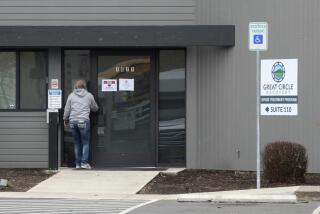Rural Areas a Hard Sell for Doctors
- Share via
PRINEVILLE, Ore. — The landscape around this high desert community is dry and desolate, and the town is the last of any size within 30 miles. Nestled in a valley below ridges of exposed rock, Prineville is favored by fly fishermen, elk hunters and horseback riders.
But this city of 7,400 is a harder sell for doctors coming out of medical schools in big cities. A position for an internist at Prineville’s Pioneer Memorial Hospital has gone unfilled for a year and a half.
Buffeted by rising costs and declining Medicare and Medicaid reimbursement rates, rural physicians say practicing medicine in the countryside is increasingly a money-losing proposition. Many doctors are avoiding rural areas and working in cities, where their hours are typically shorter and their costs lower.
In Oregon, 14 hospitals, four clinics and two health departments in rural areas are short 70 physicians, according to the Office of Rural Health at Oregon Health & Sciences University.
Nationwide, at least 1,500 positions for rural doctors are vacant, according to the Madison, Wis.-based Rural Recruitment and Retention Network.
“The people that have insurance live in cities,” said Roger Piepenbrink, a Navy-trained internist at Pioneer Memorial, who is now the town’s only such doctor.
“It’s hard to make a living off subsidized medicine,” he said. “You can make your overhead, but you can’t pay yourself.”
Piepenbrink, a specialist in osteoporosis, said he is on call vastly more often than an urban counterpart, earns less and has no colleagues down the hall to consult.
The other internist left in 2002, moving to Bend to the south for personal reasons, Piepenbrink said. This put Prineville in a quandary that has become typical for rural communities.
Three candidates for the second internist position have visited, said Don Wee, hospital director. The last, a graduate of a New York City medical school, came 10 months ago.
“It just wasn’t a good fit,” Wee said about the candidates.
All were treated to dinner, introduced to the local medical community of about a dozen doctors and shown real estate. But none wanted to move to Prineville.
The shortage of doctors and specialists has a significant impact on a community’s residents. They often have to travel long distances for care, or wait weeks or months for scarce appointments. Because of a shortage of obstetricians in Prineville, some women choose to have their babies 34 miles away in Bend, Piepenbrink said.
The dwindling pool of rural physicians drew the attention of the state Legislature this summer. It passed a law subsidizing malpractice insurance for rural physicians with a $10-million fund. Oregon already offers $5,000 state tax credits to rural doctors, and pays rural hospitals more for Medicaid patients.
At the same time, faced with a state budget crunch in the recession, the Legislature cut rates for the Oregon Health Plan, the state’s version of Medicaid. It also stripped Rural Health Assn. grants.
Nationwide, states raised Medicaid rates this year on average 9%, lagging behind inflation in private medical insurance premiums of about 14%.
Also, the Northwest’s payments to doctors for Medicare, the federal insurance for the elderly, are among the lowest in the country, said Paul McGinnis, director of field services for the Office of Rural Health at Oregon Health & Sciences University.
Lower Medicaid and Medicare rates hurt country doctors more than urban and suburban doctors because the percentage of public health recipients is greater in rural areas.
In Prineville, between 50% and 60% of the patients at Pioneer Memorial are on Medicare, while 12% to 15% are on Medicaid, according to Wee.
Both compensate at about 60% of market rates.
Other problems for doctors include a low volume of patients, while the cost of equipment and malpractice insurance are the same as in a city.
A survey this summer by the Oregon Medical Assn. showed rural doctors on call more hours than their nonrural counterparts. While the state average was 40 hours a week, doctors in central Oregon averaged 46 and in rural eastern Oregon 61 hours.
The survey also showed doctor’s practices closing at a greater rate in rural areas than in the state as a whole.
Statewide, 4% of doctors recently closed or plan to close their practices because of rising costs, according to the survey. In some rural areas, such as eastern Oregon, the rate was more than 10%.
The rapidly changing, high-priced world of modern medicine is colliding with the traditions of a country doctor, said Piepenbrink, who moved three years ago from Pensacola, Fla.
“Hopefully, you had your friendly family doctor all through your life, but how he runs his practice has changed completely,” he said.
“The face stays the same, but the guts of it are changing. The industry is changing, and the rural community has not answered” with more incentives for doctors, Piepenbrink said. “It may take more doctors leaving for this community to find out” something is wrong.
More to Read
Sign up for Essential California
The most important California stories and recommendations in your inbox every morning.
You may occasionally receive promotional content from the Los Angeles Times.













